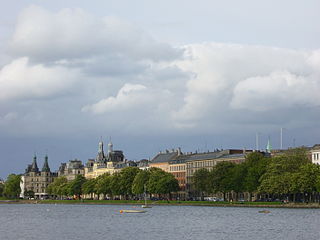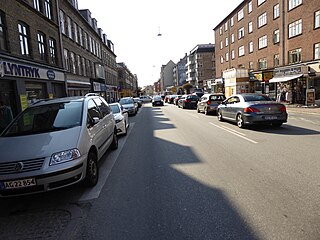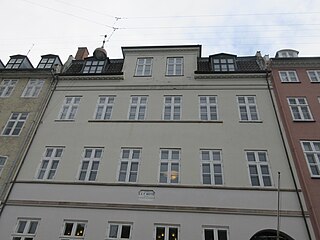
Nørre Gymnasium is one of Copenhagen’s largest gymnasiums offering both Danish instruction as well as the International Baccalaureate curriculum. It was founded in 1818 by Caroline Wroblewsky as a school for young girls, and since 1972 it has been located in Husum, Denmark.

Folketeatret is a theatre in Copenhagen, Denmark. The theatre was founded in 1857, after an initiative from actor and theater director Hans Wilhelm Lange (1815-1873) who managed the theater until his death in 1873. Folketeatret is now operated as a part of the Københavns Teater in affiliation with the Betty Nansen Teatret, Østre Gasværk Teater and Nørrebros Theater.

Porcelænshaven in the Frederiksberg district of Copenhagen, Denmark, is the former premises of the Royal Porcelain Manufactury, an industrial complex dating from the 1880s which was converted into a mixed-use neighbourhood in the 2000s. Located on the corner of Søndre Fasanvej and Smallegade, adjacent to Frederiksberg Gardens, it has an area of about five hectares and consists of a mixture of dwellings, commercial space and premises for Copenhagen Business School, whose main campus is located nearby. Many of the historical buildings have been retained, including a landmark chimney and the listed director's residence from 1908.

Blegdamsvej is a street in Copenhagen, Denmark, connecting Sankt Hans Torv in Nørrebro to Trianglen in Østerbro. The busy artery Fredensgade separates the Nørrebro and Østerbro sections of the street from each other. The north side of the street is dominated by the Panum Building and Rigshospitalet, located on either side of Tagensvej.

Nansensgade is a street in central Copenhagen, Denmark, linking Gyldenløvesgade in the southwest with Gothersgade in the northeast. The street is known for its abundance of cafés and trendy shops, and plays host to an annual street festival. Charlotte Ammundsens Plads, located in front of the local community centre, is an urban space which connects Nansensgade to Nørre Søgade

Nørregade is a street in central Copenhagen, Denmark, linking Gammeltorv in the south with Nørre Voldgade in the north. Landmarks in the street include Church of Our Lady, Bispegården, St. Peter's Church and Folketeatret.

Vester, Nørre and Øster Søgade is a succession of streets along the eastern side of The Lakes in central Copenhagen, Denmark. The streets run from Gammel Kongevej to the south to the beginning of Østerbrogade at Lille Trianglen in the north. Vester Søgade runs from Gammel Kongevej to Gyldenløvesgade, Nørre Søgade runs from Gyldenløvesgade to Dronning Louises Bro, and Øster Søgade from Dronning Louises Bro to Lille Triangel.

Vester Farimagsgade, Nørre Farimagsgade and Øster Farimagsgade is a succession of streets which together connect the south-western Vesterbro to the northern Østerbro along the periphery of the city centre in Copenhagen, Denmark. A continuation of Reventlowsgade, Vester Farimagsgade extends from Vesterbrogade at Vesterport Station and initially runs along the sunken railway tracks on the left before soon reaching H. C. Andersens Boulevard. It then turns into Nørre Farimagsgade and continues behind Ørsted Park to Gothersgade where it becomes Øster Farimagsgade and proceeds along another green space, the Copenhagen Botanical Garden, passes Sølvtorvet and the neighbourhood of terraced houses known as Kartoffelrækkerne before terminating at Lille Triangel where Østerbrogade begins.

H. C. Ørsteds Vej is a street in the Frederiksberg district of Copenhagen, Denmark. It runs from Gammel Kongevej in the south to Åboulevard on the border with Nørrebro in the north, linking Alhambravej in the south with Griffenfeldsgade in the north.

Valby Langgade is one of the main streets of the Valby district of Copenhagen, Denmark. The c. 3.2 km long street runs from the southern end of Pile Allé and the Carlsberg neighbourhood in the east to Roskildevej at Damhus Lake in the west. The square and side street Valby Tingsted was the centre of the original village of Valby.

The Royal Danish Silk Manufactury was located at Bredgade 34 and 36 in Copenhagen, Denmark. The building fronting the street at No. 34 was listed on the Danish registry of protected buildings and placed by the Danish Heritage Agency on 12 March 1951. The rear wings and the building at No.36 are not listed.

Kronprinsessegade 36 is a Neoclassical property overlooking Rosenborg Castle Garden in central Copenhagen, Denmark. A plaque embedded in the wall between the first and second floor commemorates that the composer Christoph Ernst Friedrich Weyse lived in the building from 1825 to 1842.

Steffen Peder Anker Heegaard was a Danish industrialist. His company was headquartered in Havnegade in Copenhagen and operated two manufacturing sites in Nørrebro and Frederiksværk. Products included cast ironware, steam engines and agricultural machines. He was a member of the Copenhagen City Council from 1868 to 1885 and president of Industriforeningen from 1871 to 1876.

Georg Christian Bestle was a Danish vintner. He established his own company in 1882, which had by the 1890s developed into the largest company of its kind in Denmark. Its former headquarters is located at Skindergade 45–47 in Copenhagen. The current building is from 1900.

Heimdalsgade is a street in the Outer Nørrebro district of Copenhagen, Denmark. It runs from Nørrebrogade in the southwest to Tagensvej in the northeast. A short section of the street, from Mimersgade to Slejpnersgade, disappeared when Superkilen was established.

Andreas Nicolai Hansen was a Danish businessman and landowner. His former town mansion in Copenhagen was listed on the Danish registry of protected buildings and places in 1939.

Store Mariendal was a country house at Strandvejen 135 in Hellerup, on the border between Copenhagen and Gentofte municipalities, Copenhagen, Denmark. It was operated as a hotel and entertainment venue in the 1900s and 1910s and served as the residence of Prince Viggo from 1931 to 1970. The building was demolished in 1977 and a housing estate with 121 apartments by the same name is now located at the site.

Rosenborggade 7–9 is a complex of mid-19th-century buildings situated at the corner of Rosenborggade and Tornebuskegade, close to Nørreport station, in the Old Town of Copenhagen, Denmark. It consists of a large corner building, an adjacent building in Rosenborggade and a warehouse in the courtyard. The entire complex was listed in the Danish registry of protected buildings and places in 1975. A plaque on the facade of No. 7 commemorates that the philosopher Søren Kierkegaard resided in the building from 1848 to 1850 and that he wrote The Sickness unto Death and Practice in Christianity while he lived there. Other notable former residents include the actors Ludvig and Louise Phister who lived in the apartment on the second floor of No. 7 from 1859 until their deaths in 1896 and 1916.

Admiralgade 25/Laksegade 32 is a Neoclassical property situated at the corner of Admiralgade and Laksegade in central Copenhagen, Denmark. It was constructed for goldsmith Christian Nielsen Lindbach after his previous building on the site had been destroyed in the Copenhagen Fire of 1795. It was listed in the Danish registry of protected buildings and places in 1939.

Skindergade 32/Fiolstræde 2 is a Neoclassical apartment building situated at the acute corner of Skindergade and Fiolstræde in the Old Town of Copenhagen, Denmark, designed and constructed by master mason Thomas Blom in 1837–38as his last independent work. He went with a somewhat outdated Neoclassical style, undoubtedly to make the building blend in with Christian Frederik Hansen's Trøstens Boliger, Church of Our Lady and Metropolitan School on three adjacent sites. The building was listed in the Danish registry of protected buuildings and places in 1945. Notable former residents include the mathematician Christian Ramus, judge and later professor of law at the University of Copenhagen Tage Algreen-Ussing, lawyer Lars Christian Larsen, director of the Zealand Railway Company Viggo Rothe and bookseller and publisher G.E.C. Gad.






















